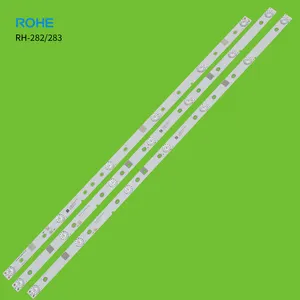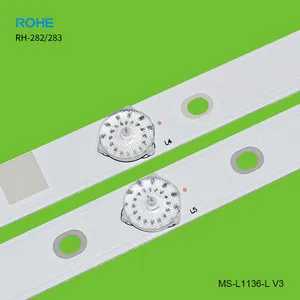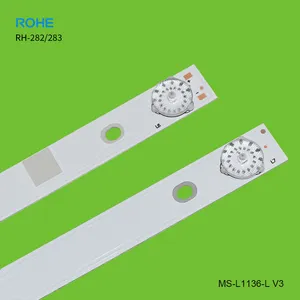
All categories
Featured selections
Trade Assurance
Buyer Central
Help Center
Get the app
Become a supplier

(15167 products available)


















































LED strip lights are flexible circuit boards with light-emitting diodes. They come with an adhesive backing that allows for easy installation in various locations. LED strip lights are widely used for lighting in automobiles, backlighting, task lighting, accent lighting, and indoor and outdoor lighting. They are popular because they use energy efficiently, have a long lifespan, and are versatile. These lights can be used for decorative and functional purposes.
LED strip lights are divided into different types based on their colors, adhesive backing, waterproof ability, and power consumption.
LED strip lights have revolutionized lighting technology due to their versatility. They can be used for accent, ambient, task, and decorative lighting. These lights can be customized to suit different applications. They can be used for lighting in homes, offices, vehicles, and outdoor spaces.
Features of LED strip lights include;
LED Density
The density of the LED lights on the strip affects brightness. It also affects power consumption and the light's uniformity. Strips with high-density LEDs provide brighter light. They also consume power differently from the low-density strips. The low-density strips have less brightness and more uniformity of light. The LED density is measured in LEDs per meter.
Color Temperature
Color temperature is the measure of the light's color. It ranges from warm to cool. It is measured in Kelvin (K). The LED strip color temperature feature helps choose the desired lighting ambience. Cool lights have a temperature of 5000K to 7000K. These are good for task-oriented areas like offices and kitchens. Warm lights have a temperature of 2700K to 3000K. These are used in living areas and bedrooms.
Color Rendering Index (CRI)
CRI is a measure of how the light affects the way colors appear. It is affected by the light source. LED strip lights with a high CRI make colors appear more natural and accurate. The index ranges from 0 to 100. Lights with a CRI above 80 are considered good.
Dimmability
Dimmable LED strip lights allow adjusting the brightness. This helps in creating the desired ambience. They also enable power saving. Not all LED strips have dimmability features, but they can be controlled using a compatible dimmer switch.
IP Rating
The Ingress Protection (IP) rating shows how the LED strip lights resist dust and water. The rating is important when using the strips in different environments like outdoors and in wet areas. The rating is shown by two digits. The first digit shows the level of protection from dust particles. The second one shows protection from water. The higher the number, the more protected the LED light strip is.
Flexible Circuit Board
The LED strip lights have a flexible PCB. This allows the lights to be installed on curved and uneven surfaces. Proper installation increases the light's efficiency and longevity.
Voltage
LED strip lights can operate on either 12V or 24V. The lower voltage strips have an increased energy efficiency. They also have reduced heat output. The choice of voltage depends on the specific lighting application.
LED strip lights have a wide range of usage scenarios across different industries and applications. Here are some common usage scenarios:
Residential Lighting
LED strips can be installed in kitchens, bathrooms, living rooms and bedrooms. They provide ambient lighting, task lighting or accent lighting. For instance, under-cabinet kitchen lights for illuminating countertops. Also, LED strip lights for cove lighting in living rooms and bedrooms for a soft glow.
Commercial Lighting
These lights are used for ambient illumination in offices, retail stores and restaurants. They improve the overall brightness and can be customized to match branding colors. Also, LED light strips for task lighting in workspaces to illuminate desks and conference rooms.
Automotive Lighting
LEDs are used for interior lighting in cars, motorcycles and other vehicles. They are installed on dashboards, footwells and door panels. More importantly, they provide a subtle illumination. Additionally, they are used for exterior lighting. For example, underglow lights on motorcycles and brake lights on vehicles.
Architectural Lighting
They accentuate building features such as walls, columns, and ledges. This is done by installing them on the ledges, corners or along the walls. Also, they enhance landscape elements like trees, pathways and water features. They are installed on pathways, driveways and around ponds or fountains.
Decorative Lighting
LED strips add color and illumination to party and event decorations. They can be wrapped around tables, centerpieces or along walls. This creates a festive atmosphere. Additionally, they create illumination and color effects on picture frames, mirrors and shelving units.
Underlighting
Strip lights can be mounted on the underside of furniture such as beds, sofas and cabinets. This provides a soft glow and enhances the ambience of a room. Additionally, they can be installed under countertops in kitchens and bathrooms for subtle illumination.
Task Lighting
LED strips can be installed on work desks, drafting tables or shelving units. This ensures bright and even lighting for reading, writing or working on tasks. Further, they can be attached to the underside of cabinets in kitchens or bathrooms for task-oriented lighting.
Recessed Lighting
These lights can be placed in recessed niches, alcoves or walls. This creates a modern and sleek lighting solution. They can also be used in coffered ceilings or tray ceilings for subtle illumination.
When buying LED strip lights, buyers should consider several factors to ensure they stock items that meet their customers' needs. They include:
Type of LED light
Business customers will want to install LED light strips in different places. They will look for light strips suitable for specific locations. Buyers should stock flexible LED light strips for use on curved surfaces such as furniture edges and car interiors. Rigid LED light bars are suitable for use on flat surfaces like walls and countertops. Waterproof LED light strips are suitable for both wet and dry locations. Customers will use them to install ambient lighting in bathrooms, kitchens, and outdoor patios.
Color temperature and color
Different customers have varying preferences when it comes to color and color temperature. Buyers should get LED strip lights with different color temperatures. This will enable business customers to make purchases based on whether they want warm or cool lighting. Moreover, to cater to customers who want to create unique ambiances by combining different colors, buyers should get color-changing LED light strips.
Brightness
Different customers have different desires when it comes to lighting brightness. Buyers should get LED light strips with varying brightness levels. This will enable business customers to purchase lights suitable for their desired ambiance. Also, buyers should get LED strips with adjustable brightness. Such options will appeal to customers looking for lighting solutions that they can customize to meet their various needs.
Power supply and voltage
To ensure customers get LED light strips that will work properly, buyers should stock options that require different power supplies. They should also ensure they have both low-voltage (12V and 24V) and high-voltage (120V) LED light strips.
Easy installation
To ensure customers get LED light strips that will work properly, buyers should stock options that require different power supplies. They should also ensure they have both low-voltage (12V and 24V) and high-voltage (120V) LED light strips.
Q1: Do LED strip lights require a special power supply?
A1: LED strip lights do not require a special power supply, but they do require a power supply compatible with the voltage and specifications of the LED strip. For instance, a 12V LED strip light will need a 12V power supply.
Q2: Can LED strip lights be left on 24 hours a day?
A2: LED strip lights can be left on for 24 hours. They are designed for extended use, and unlike traditional lights, they will not overheat or cause any damage to the strips or the users.
Q3: Can LED strip lights be waterproofed?
A3: LED strip lights cannot be waterproof, but some types are waterproof, such as the IP65, IP67, or IP68 waterproof LED strips. These strips have a silicone coating that prevents water from getting inside the strips.